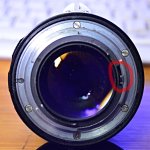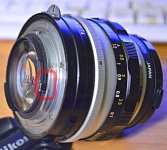Answer with a question,does the EXIF record the aperture used or the aperture the camera says its going to use,if its the second then it could be the lens aperture not closing down properly,could you run a few days on CL to see if it makes any difference.
Good question, with an obvious answer, and perhaps a clue to the problem.
The body controls the lens' aperture by way of a mechanical linkage. The body decides what aperture it means to set, and moves that linkage accordingly. I very much doubt if there is any way for the body to know that the lens actually stops down correctly to the aperture that it means to set, so the aperture recorded in the EXIF must be the aperture that the body intended to set.
Now, with that in mind, look at the bokeh of the two pictures. I realized this, as I was writing the previous paragraph, with the pictures not in view at the time, that I had noticed a difference, and I looked back, and sure enough there it is. In the lighter picture, the background is farther out of focus than in the darker picture.
I think this indicates that in the lighter picture, the aperture was open wider than in the darker picture. Between the body working the mechanical linkage to tell the lens how far to stop down, and the lens trying to respond to this linkage, it is apparent that in the end, the lens is not always stopping down as far as it is supposed to.
Did I see the OP,
@wev, mention having two D5300 bodies? If so, try the same lens on the other body, and see if you get the same behavior. This will help nail down whether the problem is with the body or with the lens.
Also, it may be helpful, just with the lens itself, not mounted to a body, to work that linkage by hand, and verify whether the aperture is working smoothly and consistently in response thereto.




